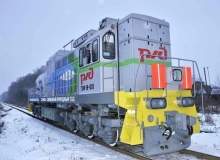

It was only a matter of time before Russia began to seriously look into the potential marriage of liquefied natural gas (LNG) and its railway network.

Discover B2B Marketing That Performs
Combine business intelligence and editorial excellence to reach engaged professionals across 36 leading media platforms.
In fact, given its vast natural gas reserves, and state-owned Russian Railways’ ascendancy to becoming one of the world’s largest transportation companies, some would argue that it should have happened sooner.
Nonetheless, the ongoing testing of gas-reciprocating traction technology, conducted by the Russian Institute of Research, Design and Technological Studies – as commissioned by the Russian Railways – could well beget a switch from diesel to LNG on the country’s tracks.
Positive vital signs: Trialling the TEM19, "the world’s first LNG locomotive"
Trials on what has been described as the world’s first LNG-generated locomotive, the TEM19, first began in 2013 on the Golutvin-Karasevo line, near the Russian capital Moscow. In September of that year, it was recognised with an innovation award in the locomotives and rolling stock category at the Expo 1520 exhibition.
While Russian Railways has kept something of a tight lid on the tests (senior vice president, Valentin Gapanovich declined to be interviewed for this article), the results that have been drip-fed to the public appear to be overwhelmingly positive.

US Tariffs are shifting - will you react or anticipate?
Don’t let policy changes catch you off guard. Stay proactive with real-time data and expert analysis.
By GlobalDataThe TEM19 has already completed over 300 hours of running time. In addition, the primary and secondary circuits of the six-axle engine have been verified, while the algorithms required for feeding natural gas to the engine have also been attuned.
The Honolulu Rail Transit Project is building 20 miles of elevated track across Hawaii’s capital city, bringing welcome relief to its traffic-stricken roads.
The locomotive is based on a modular design, aimed at driving down locomotive maintenance and repair work. Notable features include a driver’s cab, cooling system, LNG feeder systems, motor-generator set, equipment chamber, compressor unit and electro-dynamic braking equipment.
The TEM19 is also significantly predicated on cryogenics. Fuel is kept in a detachable tank at the front of the engine, while the propulsion unit constitutes a motor-generator, powered by LNG.
The cryogenic unit module is also made up of a cryogenic tank fitted with gas distribution and refilling systems, a gas pressure regulator, product evaporator and gas receiver. The gas distribution system has a stainless steel pipeline along with shutoff and safety valves.
Mountings from a standard 20-feet container are deployed on the cryogenic LNG storage tank, creating a cartridge system effect, in which it allows for the speedy replacement of empty tanks from a depot.
In addition, the TEM19’s propulsion unit is run by a multiprocessor control and diagnostic system, enabling better performance of the locomotive’s engine. It also provides programme ¬level control of engine start-up and shutdown, with all the relevant information evinced on a control panel screen.
In light of last year’s metro crash in Moscow, in which 21 commuters died, Russian Railways’ decision to invest in cutting-edge safety technology is an apt one. The TEM19 is equipped with an integrated telematic system, able to record and gauge driver behaviour. Given the potential dangers that come with working with LNG, the locomotive also has an automated fire and gas detection system.
The death of diesel: Why is LNG such an attractive alternative?
But what clear advantages can LNG offer over diesel as a viable 21st century fuel alternative for powering a rail network as sizeable as Russia’s?
The first point to consider relates to cost. Diesel prices in Europe remain considerably higher than natural gas on an energy-equivalent basis. Furthermore, the cost of LNG is not contingent on the vacillating performance of Crude oil prices, unlike diesel.
The claim by Russian Railways that the TEM19 offers a 24% reduction in energy costs seems far from spurious.
Environmental factors also strike a resonant note; LNG produces far fewer pollutants than diesel. Just as the automobile industry has sought to burnish its green credentials through the development of hybrid technology, the railway sector, as a whole, would do well to follow suit.
In terms of the TEM19, other benefits include its deployment of removable cylinder tanks, which strips away the considerable amount of time usually needed to fit out a locomotive. With antifreeze used as a coolant, the engine also requires less time to warm up in colder conditions. According to Russian Railways, infrastructure costs could be slashed, too.
Of course, Russia isn’t the only country currently reviewing the pros of LNG-propelled rail systems. Tests continue to be carried out in the US, while Indian Railways recently announced its plans to float a tender with regards to developing its first LNG-based service. Several Russian companies are said to have expressed interest in the project.
Stumbling block: Can investment in LNG take place in a weak Russian economy?
Returning to TEM19 – and its commercialisation – much could be dependent on whether Russia is to see any semblance of resurgence in its currently beleaguered economy. It seems unthinkable that the free flow of investment that has come from the coffers of Russian Railways in recent years – and which financed the TEM19 project – can continue apace in 2015.
However, Russian Railways is bullish, and claims that mass production of the TEM19 could begin later this year. While the future is uncertain, a future of LNG-powered railroads in Russia – and further afield – should not be underestimated.





